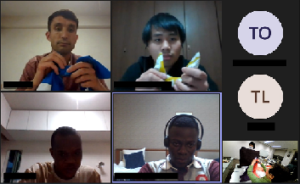Date & Time: Wednesday, April 20, 6:00 p.m. – 7:00 p.m.
Spot: Japan International Cooperation Agency (JICA) Yokohama. Participants joined from each hotel room through Zoom
Participants: Four participants (from Vietnam, Afghanistan, Benin, Ghana) and a staff of JICA Yokohama
Instructors: Kozue, Kiyomi, Akiko, KSGG members
Languages: English
Report by Akiko
Four participants who were taking training courses at JICA Yokohama, joined in a furoshiki workshop hosted by KSGG to wrap things with a big and square cloth. Since the workshop was held on Friday, it started at 6:00 p.m. after their regular JICA training courses. First, we started with an overview of the history of furoshiki, and its various wrapping methods. After that, we introduced how to wrap items with a furoshiki by a method called Hon-musubi*1. With this basic method, the items can be unwrapped easily. The participants who tried and succeeded in wrapping and unwrapping a furoshiki shouted with joy.
We also introduced three other wrapping methods: wrapping a square box, a bottle, and a spherical object such as a watermelon. All the participants enthusiastically looked at our demonstration and tried each wrapping method.
Some of the participants asked us to introduce how to carry items on their back with a furoshiki. We showed them the wrapping method they requested. One of them who tried this method managed to make the bag with it. He showed a big smile and pretended to go out with the bag.
Since the left and right sides of the screen images are reversed when working with Zoom, this was complicated for them. We changed the position of the camera so that they could see the instructor’s hands from the same direction. This workshop was successfully held thanks to the instruction document sent to them in advance. At the end of the activity, everyone seemed to be contented with the training.
*1 One of the names of how to bind the rope. Hon-musubi is the Japanese name for the reef knot or square knot.

